Qiang Luo
OneRec-V2 Technical Report
Aug 28, 2025Abstract:Recent breakthroughs in generative AI have transformed recommender systems through end-to-end generation. OneRec reformulates recommendation as an autoregressive generation task, achieving high Model FLOPs Utilization. While OneRec-V1 has shown significant empirical success in real-world deployment, two critical challenges hinder its scalability and performance: (1) inefficient computational allocation where 97.66% of resources are consumed by sequence encoding rather than generation, and (2) limitations in reinforcement learning relying solely on reward models. To address these challenges, we propose OneRec-V2, featuring: (1) Lazy Decoder-Only Architecture: Eliminates encoder bottlenecks, reducing total computation by 94% and training resources by 90%, enabling successful scaling to 8B parameters. (2) Preference Alignment with Real-World User Interactions: Incorporates Duration-Aware Reward Shaping and Adaptive Ratio Clipping to better align with user preferences using real-world feedback. Extensive A/B tests on Kuaishou demonstrate OneRec-V2's effectiveness, improving App Stay Time by 0.467%/0.741% while balancing multi-objective recommendations. This work advances generative recommendation scalability and alignment with real-world feedback, representing a step forward in the development of end-to-end recommender systems.
OneLoc: Geo-Aware Generative Recommender Systems for Local Life Service
Aug 20, 2025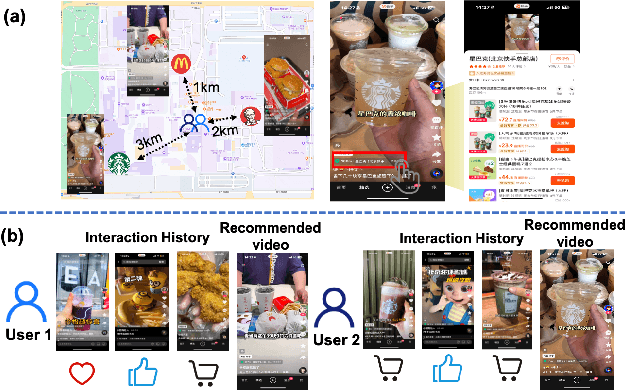
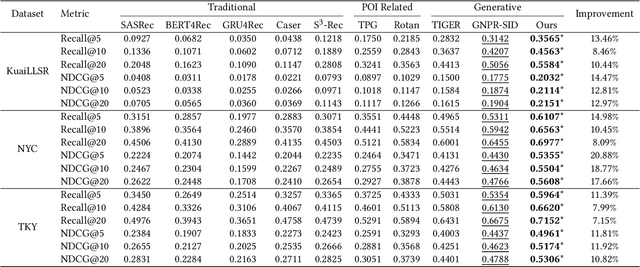
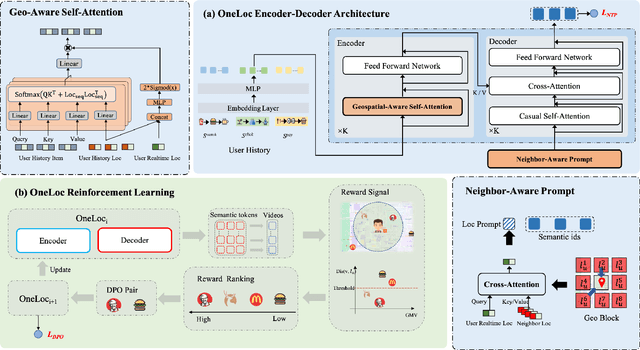

Abstract:Local life service is a vital scenario in Kuaishou App, where video recommendation is intrinsically linked with store's location information. Thus, recommendation in our scenario is challenging because we should take into account user's interest and real-time location at the same time. In the face of such complex scenarios, end-to-end generative recommendation has emerged as a new paradigm, such as OneRec in the short video scenario, OneSug in the search scenario, and EGA in the advertising scenario. However, in local life service, an end-to-end generative recommendation model has not yet been developed as there are some key challenges to be solved. The first challenge is how to make full use of geographic information. The second challenge is how to balance multiple objectives, including user interests, the distance between user and stores, and some other business objectives. To address the challenges, we propose OneLoc. Specifically, we leverage geographic information from different perspectives: (1) geo-aware semantic ID incorporates both video and geographic information for tokenization, (2) geo-aware self-attention in the encoder leverages both video location similarity and user's real-time location, and (3) neighbor-aware prompt captures rich context information surrounding users for generation. To balance multiple objectives, we use reinforcement learning and propose two reward functions, i.e., geographic reward and GMV reward. With the above design, OneLoc achieves outstanding offline and online performance. In fact, OneLoc has been deployed in local life service of Kuaishou App. It serves 400 million active users daily, achieving 21.016% and 17.891% improvements in terms of gross merchandise value (GMV) and orders numbers.
MISS: Multi-Modal Tree Indexing and Searching with Lifelong Sequential Behavior for Retrieval Recommendation
Aug 20, 2025



Abstract:Large-scale industrial recommendation systems typically employ a two-stage paradigm of retrieval and ranking to handle huge amounts of information. Recent research focuses on improving the performance of retrieval model. A promising way is to introduce extensive information about users and items. On one hand, lifelong sequential behavior is valuable. Existing lifelong behavior modeling methods in ranking stage focus on the interaction of lifelong behavior and candidate items from retrieval stage. In retrieval stage, it is difficult to utilize lifelong behavior because of a large corpus of candidate items. On the other hand, existing retrieval methods mostly relay on interaction information, potentially disregarding valuable multi-modal information. To solve these problems, we represent the pioneering exploration of leveraging multi-modal information and lifelong sequence model within the advanced tree-based retrieval model. We propose Multi-modal Indexing and Searching with lifelong Sequence (MISS), which contains a multi-modal index tree and a multi-modal lifelong sequence modeling module. Specifically, for better index structure, we propose multi-modal index tree, which is built using the multi-modal embedding to precisely represent item similarity. To precisely capture diverse user interests in user lifelong sequence, we propose collaborative general search unit (Co-GSU) and multi-modal general search unit (MM-GSU) for multi-perspective interests searching.
OneRec Technical Report
Jun 16, 2025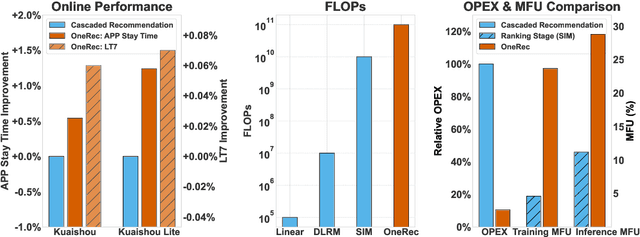

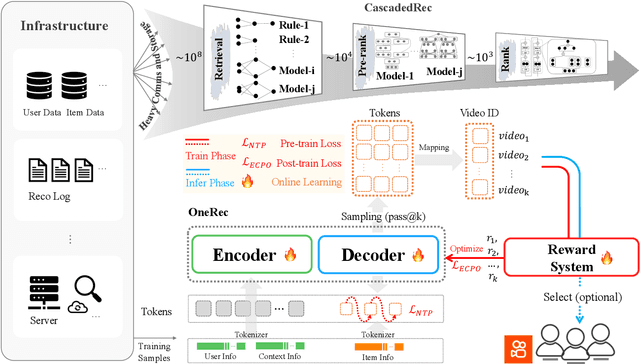

Abstract:Recommender systems have been widely used in various large-scale user-oriented platforms for many years. However, compared to the rapid developments in the AI community, recommendation systems have not achieved a breakthrough in recent years. For instance, they still rely on a multi-stage cascaded architecture rather than an end-to-end approach, leading to computational fragmentation and optimization inconsistencies, and hindering the effective application of key breakthrough technologies from the AI community in recommendation scenarios. To address these issues, we propose OneRec, which reshapes the recommendation system through an end-to-end generative approach and achieves promising results. Firstly, we have enhanced the computational FLOPs of the current recommendation model by 10 $\times$ and have identified the scaling laws for recommendations within certain boundaries. Secondly, reinforcement learning techniques, previously difficult to apply for optimizing recommendations, show significant potential in this framework. Lastly, through infrastructure optimizations, we have achieved 23.7% and 28.8% Model FLOPs Utilization (MFU) on flagship GPUs during training and inference, respectively, aligning closely with the LLM community. This architecture significantly reduces communication and storage overhead, resulting in operating expense that is only 10.6% of traditional recommendation pipelines. Deployed in Kuaishou/Kuaishou Lite APP, it handles 25% of total queries per second, enhancing overall App Stay Time by 0.54% and 1.24%, respectively. Additionally, we have observed significant increases in metrics such as 7-day Lifetime, which is a crucial indicator of recommendation experience. We also provide practical lessons and insights derived from developing, optimizing, and maintaining a production-scale recommendation system with significant real-world impact.
FIM: Frequency-Aware Multi-View Interest Modeling for Local-Life Service Recommendation
Apr 30, 2025Abstract:People's daily lives involve numerous periodic behaviors, such as eating and traveling. Local-life platforms cater to these recurring needs by providing essential services tied to daily routines. Therefore, users' periodic intentions are reflected in their interactions with the platforms. There are two main challenges in modeling users' periodic behaviors in the local-life service recommendation systems: 1) the diverse demands of users exhibit varying periodicities, which are difficult to distinguish as they are mixed in the behavior sequences; 2) the periodic behaviors of users are subject to dynamic changes due to factors such as holidays and promotional events. Existing methods struggle to distinguish the periodicities of diverse demands and overlook the importance of dynamically capturing changes in users' periodic behaviors. To this end, we employ a Frequency-Aware Multi-View Interest Modeling framework (FIM). Specifically, we propose a multi-view search strategy that decomposes users' demands from different perspectives to separate their various periodic intentions. This allows the model to comprehensively extract their periodic features than category-searched-only methods. Moreover, we propose a frequency-domain perception and evolution module. This module uses the Fourier Transform to convert users' temporal behaviors into the frequency domain, enabling the model to dynamically perceive their periodic features. Extensive offline experiments demonstrate that FIM achieves significant improvements on public and industrial datasets, showing its capability to effectively model users' periodic intentions. Furthermore, the model has been deployed on the Kuaishou local-life service platform. Through online A/B experiments, the transaction volume has been significantly improved.
Differential Privacy Personalized Federated Learning Based on Dynamically Sparsified Client Updates
Mar 12, 2025Abstract:Personalized federated learning is extensively utilized in scenarios characterized by data heterogeneity, facilitating more efficient and automated local training on data-owning terminals. This includes the automated selection of high-performance model parameters for upload, thereby enhancing the overall training process. However, it entails significant risks of privacy leakage. Existing studies have attempted to mitigate these risks by utilizing differential privacy. Nevertheless, these studies present two major limitations: (1) The integration of differential privacy into personalized federated learning lacks sufficient personalization, leading to the introduction of excessive noise into the model. (2) It fails to adequately control the spatial scope of model update information, resulting in a suboptimal balance between data privacy and model effectiveness in differential privacy federated learning. In this paper, we propose a differentially private personalized federated learning approach that employs dynamically sparsified client updates through reparameterization and adaptive norm(DP-pFedDSU). Reparameterization training effectively selects personalized client update information, thereby reducing the quantity of updates. This approach minimizes the introduction of noise to the greatest extent possible. Additionally, dynamic adaptive norm refers to controlling the norm space of model updates during the training process, mitigating the negative impact of clipping on the update information. These strategies substantially enhance the effective integration of differential privacy and personalized federated learning. Experimental results on EMNIST, CIFAR-10, and CIFAR-100 demonstrate that our proposed scheme achieves superior performance and is well-suited for more complex personalized federated learning scenarios.
OneRec: Unifying Retrieve and Rank with Generative Recommender and Iterative Preference Alignment
Feb 26, 2025



Abstract:Recently, generative retrieval-based recommendation systems have emerged as a promising paradigm. However, most modern recommender systems adopt a retrieve-and-rank strategy, where the generative model functions only as a selector during the retrieval stage. In this paper, we propose OneRec, which replaces the cascaded learning framework with a unified generative model. To the best of our knowledge, this is the first end-to-end generative model that significantly surpasses current complex and well-designed recommender systems in real-world scenarios. Specifically, OneRec includes: 1) an encoder-decoder structure, which encodes the user's historical behavior sequences and gradually decodes the videos that the user may be interested in. We adopt sparse Mixture-of-Experts (MoE) to scale model capacity without proportionally increasing computational FLOPs. 2) a session-wise generation approach. In contrast to traditional next-item prediction, we propose a session-wise generation, which is more elegant and contextually coherent than point-by-point generation that relies on hand-crafted rules to properly combine the generated results. 3) an Iterative Preference Alignment module combined with Direct Preference Optimization (DPO) to enhance the quality of the generated results. Unlike DPO in NLP, a recommendation system typically has only one opportunity to display results for each user's browsing request, making it impossible to obtain positive and negative samples simultaneously. To address this limitation, We design a reward model to simulate user generation and customize the sampling strategy. Extensive experiments have demonstrated that a limited number of DPO samples can align user interest preferences and significantly improve the quality of generated results. We deployed OneRec in the main scene of Kuaishou, achieving a 1.6\% increase in watch-time, which is a substantial improvement.
FARM: Frequency-Aware Model for Cross-Domain Live-Streaming Recommendation
Feb 13, 2025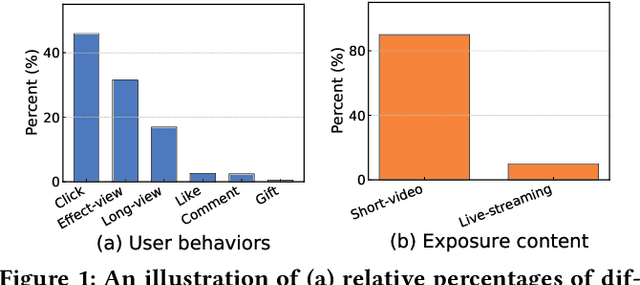

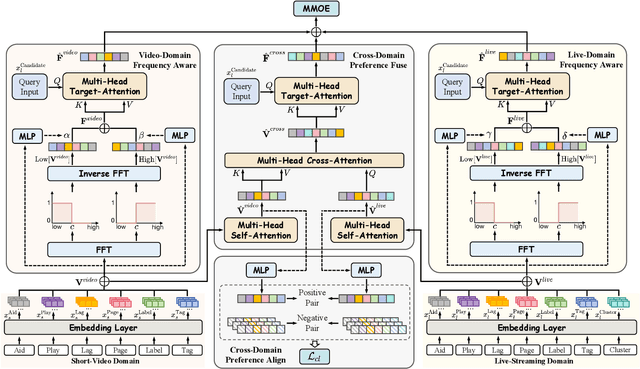

Abstract:Live-streaming services have attracted widespread popularity due to their real-time interactivity and entertainment value. Users can engage with live-streaming authors by participating in live chats, posting likes, or sending virtual gifts to convey their preferences and support. However, the live-streaming services faces serious data-sparsity problem, which can be attributed to the following two points: (1) User's valuable behaviors are usually sparse, e.g., like, comment and gift, which are easily overlooked by the model, making it difficult to describe user's personalized preference. (2) The main exposure content on our platform is short-video, which is 9 times higher than the exposed live-streaming, leading to the inability of live-streaming content to fully model user preference. To this end, we propose a Frequency-Aware Model for Cross-Domain Live-Streaming Recommendation, termed as FARM. Specifically, we first present the intra-domain frequency aware module to enable our model to perceive user's sparse yet valuable behaviors, i.e., high-frequency information, supported by the Discrete Fourier Transform (DFT). To transfer user preference across the short-video and live-streaming domains, we propose a novel preference align before fuse strategy, which consists of two parts: the cross-domain preference align module to align user preference in both domains with contrastive learning, and the cross-domain preference fuse module to further fuse user preference in both domains using a serious of tailor-designed attention mechanisms. Extensive offline experiments and online A/B testing on Kuaishou live-streaming services demonstrate the effectiveness and superiority of FARM. Our FARM has been deployed in online live-streaming services and currently serves hundreds of millions of users on Kuaishou.
CRM: Retrieval Model with Controllable Condition
Dec 18, 2024

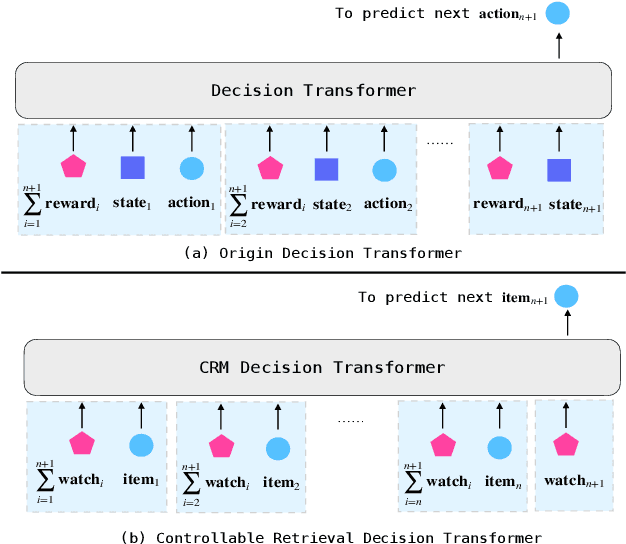
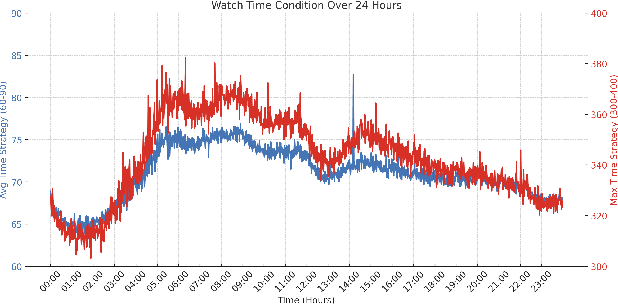
Abstract:Recommendation systems (RecSys) are designed to connect users with relevant items from a vast pool of candidates while aligning with the business goals of the platform. A typical industrial RecSys is composed of two main stages, retrieval and ranking: (1) the retrieval stage aims at searching hundreds of item candidates satisfied user interests; (2) based on the retrieved items, the ranking stage aims at selecting the best dozen items by multiple targets estimation for each item candidate, including classification and regression targets. Compared with ranking model, the retrieval model absence of item candidate information during inference, therefore retrieval models are often trained by classification target only (e.g., click-through rate), but failed to incorporate regression target (e.g., the expected watch-time), which limit the effectiveness of retrieval. In this paper, we propose the Controllable Retrieval Model (CRM), which integrates regression information as conditional features into the two-tower retrieval paradigm. This modification enables the retrieval stage could fulfill the target gap with ranking model, enhancing the retrieval model ability to search item candidates satisfied the user interests and condition effectively. We validate the effectiveness of CRM through real-world A/B testing and demonstrate its successful deployment in Kuaishou short-video recommendation system, which serves over 400 million users.
KuaiFormer: Transformer-Based Retrieval at Kuaishou
Nov 15, 2024Abstract:In large-scale content recommendation systems, retrieval serves as the initial stage in the pipeline, responsible for selecting thousands of candidate items from billions of options to pass on to ranking modules. Traditionally, the dominant retrieval method has been Embedding-Based Retrieval (EBR) using a Deep Neural Network (DNN) dual-tower structure. However, applying transformer in retrieval tasks has been the focus of recent research, though real-world industrial deployment still presents significant challenges. In this paper, we introduce KuaiFormer, a novel transformer-based retrieval framework deployed in a large-scale content recommendation system. KuaiFormer fundamentally redefines the retrieval process by shifting from conventional score estimation tasks (such as click-through rate estimate) to a transformer-driven Next Action Prediction paradigm. This shift enables more effective real-time interest acquisition and multi-interest extraction, significantly enhancing retrieval performance. KuaiFormer has been successfully integrated into Kuaishou App's short-video recommendation system since May 2024, serving over 400 million daily active users and resulting in a marked increase in average daily usage time of Kuaishou users. We provide insights into both the technical and business aspects of deploying transformer in large-scale recommendation systems, addressing practical challenges encountered during industrial implementation. Our findings offer valuable guidance for engineers and researchers aiming to leverage transformer models to optimize large-scale content recommendation systems.
 Add to Chrome
Add to Chrome Add to Firefox
Add to Firefox Add to Edge
Add to Edge